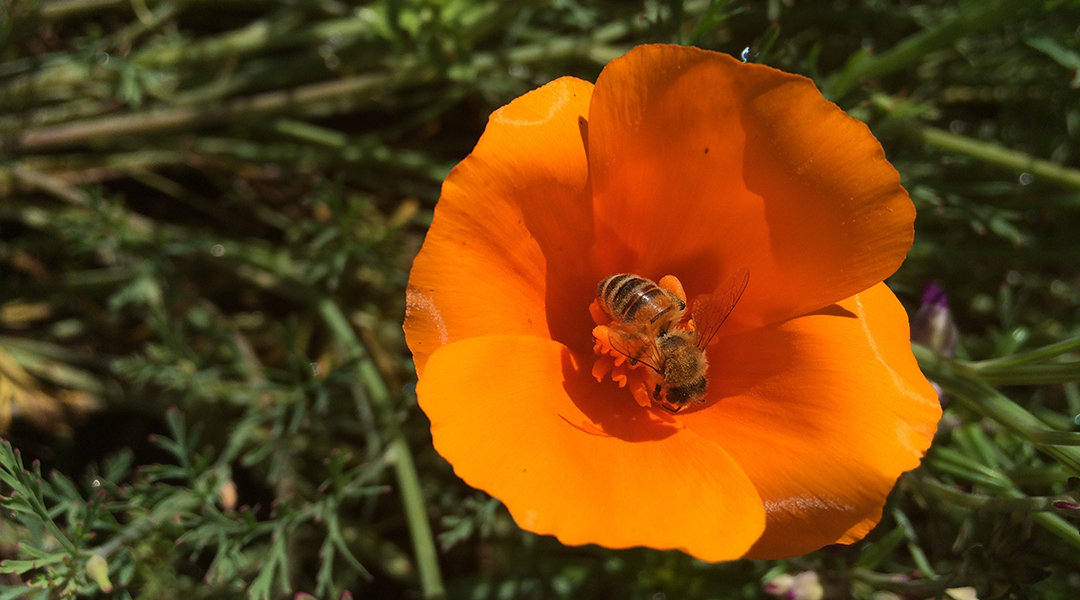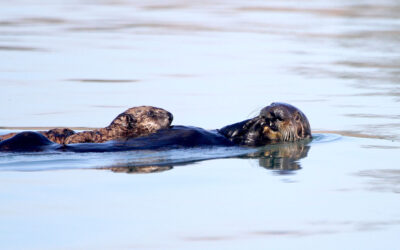In 2017, Maureen Page began collecting thousands of bees from wildflower plantings neighboring almond orchards in the California Central Valley. Surprisingly, she says she never got stung in the two years she spent collecting bees.
At the time she was a graduate student at UC Davis, and was delving into concerns that introduced honey bees in croplands used to promote crop pollination might be harming native bee species by competing with them for resources. This competition can deprive wild bees of the pollen and nectar they need to produce healthy offspring.
Attempts to mitigate these concerns include planting wildflowers around croplands to increase available resources for native bees. “Wildflower plantings are increasingly a really popular tool for supporting diverse bee populations in croplands,” said Page. “But there’s simultaneously a lot of concern about honey bee competition with native bees, and how the generally high abundance of non-native honey bees in croplands might interfere with the ability of wildflower plantings to support diverse bees.”
To study how wildflower plantings and honey bee competition impacts the diet of wild bees, Page documented bee species in the orchard, analyzed the pollen the bees collected, and determined whether or not specific wildflowers could help address the competition for resources among bees.
Page and her team hope to get to the bottom of things in order to provide a more sustainable future for crops and struggling bee species.
Learning from the field
The team sampled five sites at almond orchards in California between April and May over two years. Morning and afternoon, they walked the same paths to collect bees and identified wildflowers along the path.
They carefully removed the pollen from bee bodies, and analyzed the pollen’s nutritional value and what flowers they came from. The pollen they collect acts as a predictor for the bee’s dietary intake.
The team focused on two indicators of pollen nutrition: protein content and the ratio of protein to lipids. Lipids, which are a group of fatty compounds, including fats, waxes, and steroids, have roles in immune function, growth, and development. The protein levels in pollen have implications for native bee reproduction and offspring body size, added Page.
The team found 49 species of bees in their sample areas, but not all species responded similarly to honey bee competition. “While we saw a negative impact of honey bee competition, it was also clear that the effect varied by species,” Page said.
They noticed that honey bee abundance negatively impacted the protein content of the pollen collected by bumble bees, while they saw no effect of honey bees on the diet of sweat bees. Mason bees were negatively impacted in areas with specific types of wildflowers that are known to be less nutritious for them, but the team found that their diets weren’t impacted if they had access to higher nutritional quality of wildflowers.
This finding hints at a strategy where farmers can use wildflowers that contain higher nutritious pollen to counteract any negative effects of honey bee competition. But how feasible would this be in practice?
Tailoring wildflowers to support native bees
Although Page and her team suggest that there are ways to temper any negative effects of honey bees on native bees by choosing highly nutritious wildflower plant mixes, it’s not a one-size-fits-all approach. The best wildflower mix for one location might not be the best for another with dramatically different climate, native bee populations, and crops.
“If you want to extrapolate [the conclusions of this study] to another region in the country, you would have to use native plants that are local to that part,” said Juliana Rangel, a professor at Texas A&M University who was not involved in the study.
Page also adds that “it’s worth thinking about the floral landscape, not just in terms of the abundance of flowers… but it’s also worthwhile thinking about the nutritional landscape and what are those resources. Can we choose plants in a way that we ensure that all bees have access to nutritious pollen and nectar resources?”
Aside from finding the right mix for a specific region, there’s also timing to consider. “You would have to time the planting bloom period with the bloom period of the wildflowers,” said Rangel.
Whether this strategy is feasible or not might depend on the farm and willingness to invest resources toward initiatives like this in specific agricultural regions.
While this study looked specifically at agricultural croplands, Page points out residential gardens could also play a contributing role. “If there are situations where people are concerned about honey bee competition and its impacts on native bees, one potential tool towards reducing impacts of competition is planting diverse, nutritious flowers.”
Reference: Maureen Page et al., Wildflower plantings and honeybee competition impact nutritional quality of wild bee diets, Journal of Applied Ecology (2024). DOI: 10.1111/1365-2664.14813
Feature image credit: Maureen Page

















